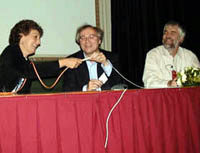3rd Biennial International Grid Applications-driven Testbed Event, Amsterdam, The Netherlands, 23-26 September 2002
June 1st, 2003
Categories: Applications, Networking, Software, Supercomputing, Tele-Immersion, Visualization, VR

Authors
Edited by DeFanti, T.A., Brown, M., de Laat, C.About
iGrid 2002: The International Virtual Laboratory
Editorial
iGrid 2002, The Third Biennial International Grid Applications-driven Testbed Event held on 23 - 26 September 2002 at the Amsterdam Science and Technology Centre (WTCW), challenged scientists and technologists to utilize multi-gigabit experimental optical networks, with special emphasis on e-Science, LambdaGrid and Virtual Laboratory applications. The result was an impressive, coordinated effort by 28 teams representing 16 countries, showcasing how extreme networks, combined with application advancements and middleware innovations, could advance scientific research.
The applications that were demonstrated included: art, bioinformatics, chemistry, cosmology, cultural heritage, education, high-definition media streaming, manufacturing, medicine, neuroscience, physics and tele-science. Each of these applications used underlying grid middleware technologies, with major emphasis on data management grids, data replication grids, visualization grids, data / visualization grids, computational grids, access grids, and grid portals. The participating countries were Australia, Canada, CERN / Switzerland, France, Finland, Germany, Greece, Italy, Japan, The Netherlands, Singapore, Spain, Sweden, Taiwan, the United Kingdom and the USA.
As computational scientists strive to better understand very complex systems - whether biological, environmental, atmospheric, geological or physics, from the micro to the macro level, in both time and space - they will require petascale computing, exabyte storage and terabit networks. A petaflop is 100 times faster than today’s largest parallel computers, which process 10 trillion floating-point operations per second (10 teraflops). An exabyte is a billion gigabytes of storage, and terabit networks will eventually transmit data at 1 trillion bits/s - some 20 million times faster than a dialup 56 K Internet connection.
Recent, major technological and cost breakthroughs in networking technology have made it possible to send scores of lambdas on a pair of customer-owned or leased optical fiber, making the terabit network of the future conceivable (here, lambda refers to a fully dedicated wavelength of light, each capable of bandwidth speeds from 1 to 10 gigabits/s). Research is moving from locally connected, processor-centric environments to distributed-computing environments that rely on optical connections, where the networks are faster than the resources they connect. Researchers are moving from grid-intensive computing to LambdaGrid-intensive computing, in which computational resources are connected by multiple lambdas.
As a conference, iGrid 2002 demonstrated application demands for increased bandwidth. As a testbed, iGrid 2002 enabled the world’s research community to work together briefly and intensely to advance the state of the art - by developing new network-control and traffic-engineering techniques; new middleware to bandwidth-match distributed resources, and new collaboration and visualization tools for real-time interaction with high-definition imagery. Much of the iGrid 2002 infrastructure will persist and be available for long-term experimentation.
LambdaGrid-intensive computing will become the main enabling technology for facilitating multi-institutional and multi-disciplinary advanced collaborations, enabling researchers to share unique resources and have uniform and ubiquitous access to these facilities. In turn, this will enable the development of Virtual Laboratories, or science portals, for distributed analysis in applied scientific research. Groups worldwide are collaborating on major research projects, creating experimental platforms upon which future e-Science and large-scale distributed-computing experiments can take place. iGrid 2002 was a window into this world.
iGrid 2002 was organized by Dutch and USA organizations. Institutions in The Netherlands were Amsterdam Science and Technology Centre, GigaPort Project, SARA Computing and Networking Services, SURFnet and Universiteit van Amsterdam / Science Faculty.
Institutions in the USA were Argonne National Laboratory / Mathematics and Computer Science Division, Indiana University / Office of the Vice President for Information Technology, Northwestern University / International Center for Advanced Internet Research, and University of Illinois at Chicago / Electronic Visualization Laboratory.
Major funding for iGrid 2002 was provided by the GigaPort Project, the Amsterdam Science and Technology Centre and the USA National Science Foundation, with in-kind support by SARA Computing and Networking Services and the Universiteit van Amsterdam. Financial support was also obtained from: NCF (Dutch foundation National Computing Facilities), Unilever, AMSIX (Amsterdam Internet Exchange), IBM, FOM (Dutch Foundation for Fundamental Research on Matter), Glimmerglass and the Amsterdam Municipality.
Resources
URL
Citation
Edited by DeFanti, T.A., Brown, M., de Laat, C., 3rd Biennial International Grid Applications-driven Testbed Event, Amsterdam, The Netherlands, 23-26 September 2002, Future Generation Computer Systems, vol 19, no 6, Elsevier Science B.V., June 1st, 2003. http://www.science.uva.nl/~delaat/elsevier-igrid2002.html